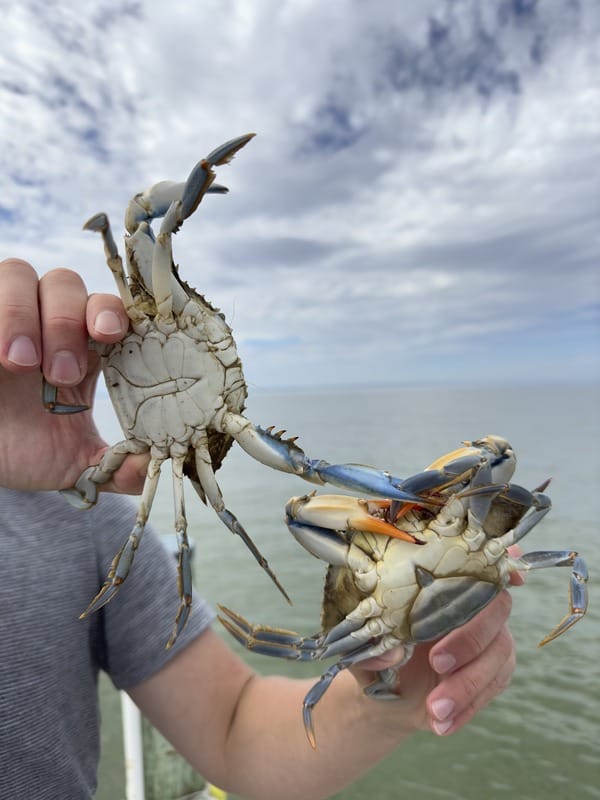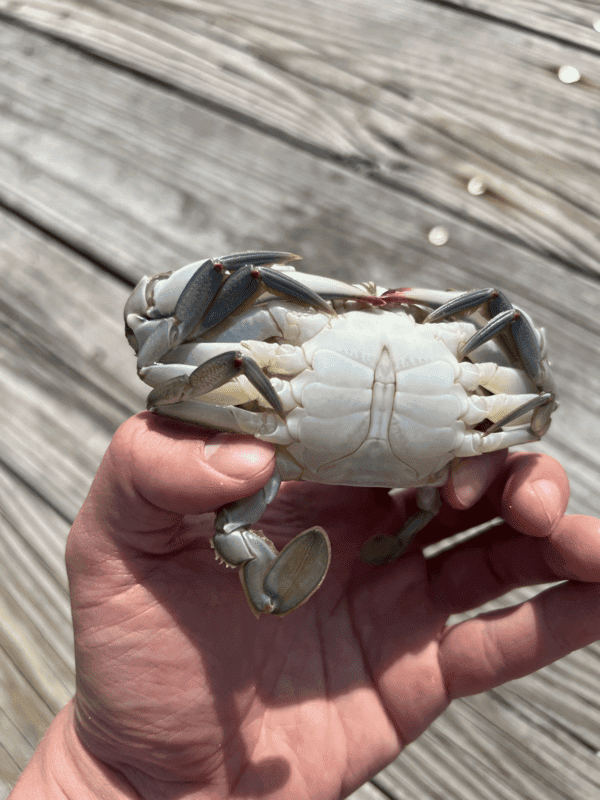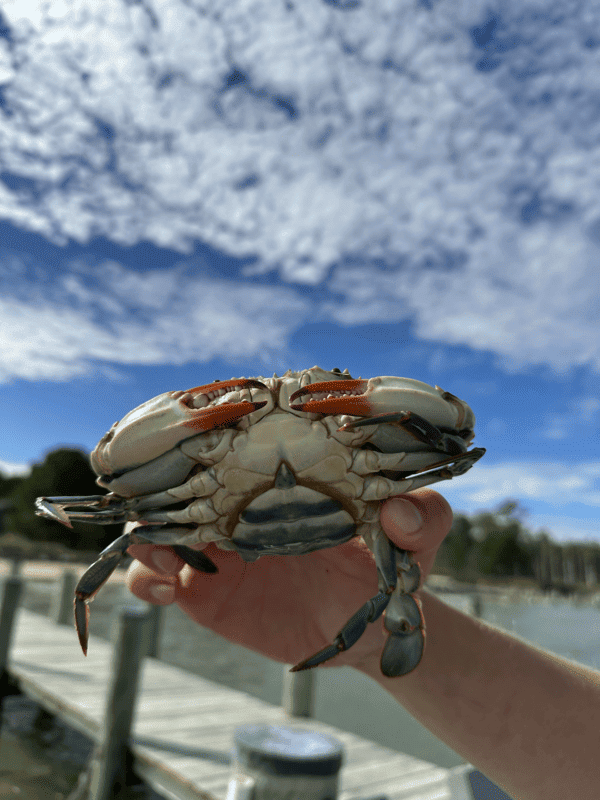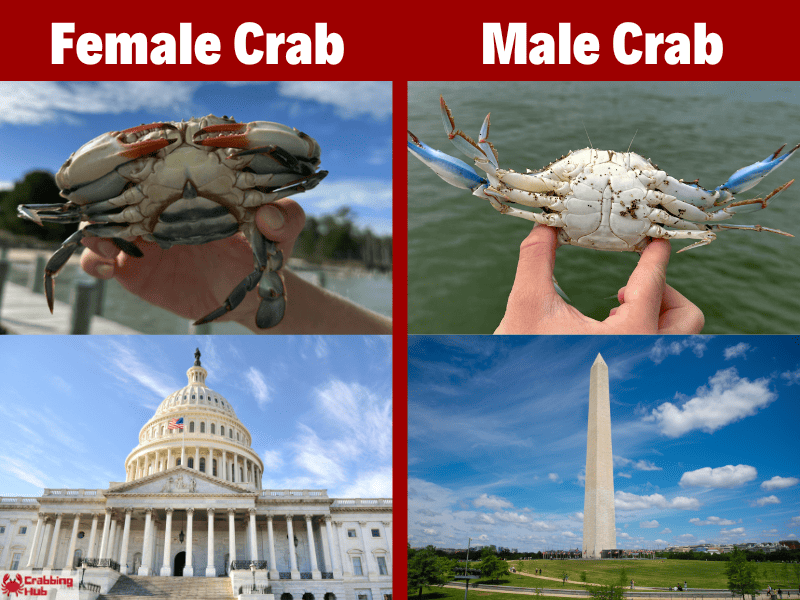The Atlantic Blue Crab is a huge part of Maryland culture and history, as well as the inspiration for starting Crabbing Hub. The purpose of this page is to better educate readers on the habitat, anatomy, and common knowledge on Callinectes sapidus.
Instead of a mundane approach of listing blue crab facts, I’m going to explain these facts from the perspective of a crabber. I’ll explain scientific information about blue crabs that will help you identify and find blue crabs, while educating you on preservation efforts. It’s important to respect and understand what you’re catching to protect the species for future generations.
Blue Crab Overview

The Atlantic Blue Crab is a small, swimming crustacean found in brackish and saltwater along the East and Gulf Coast. They have two front claws, three legs on either side of their body, and two fins to help swim. Blue crabs are scavengers, with a diet of whatever they can get their claws on. This usually includes fish, oysters, clams, snails, shrimp, worms and other crabs. They actively feed and mate from May to October, which is when we consider crabs in-season.
Diet
Following scents carried by currents, blue crabs seek out anything edible they can get their claws on. This includes fishes, oysters, clams, snails, shrimp, and worms.
Lifespan
Blue crabs live between 3 and 4 years, reaching maturity in 12 to 18 months. They grow with recurring molts, with their shell growing and hardening as they age.
Title
Blue Crab Sexual Identifiers
It’s easy to tell the difference between male and female crabs, and very important to know if you want to follow your state’s regulations. The two main differentiators are their abdomen and claw color. Male blue crabs have a pointed abdomen and blue-colored claws. Females, on the other hand, have a rounded abdomen and bright red claws.
See image (male on the left, female on the right):

Image: Taken by the author, Taylor Whiteman, holding two blue crabs caught from Taylor’s Island, MD. One male and one female.


Images: Taken by the author, Taylor Whiteman. Left: Immature male blue crab caught at Holt’s Landing, DE. Right: mature female blue crab caught at Taylor’s Island, MD.
Notice the bright red claws on the female crab shown on the right. Among fishermen, this is an easy identifier between male and female crabs. They are referred to as the crab’s “red lip stick” or “red painted finger nails” as an analogy to women painting their nails or using lip stick. You’ll hear this terminology used by crabbers in Maryland and the Chesapeake Bay (Source).

A sure-way to spot the difference between a male and a female crab is by the shape of their abdomen. A fun analogy crabbers use is that female’s have the Capitol Dome and males have the Washington Monument. Take a look at the infographic above to see the comparison.
For more information on the difference between a male and female crab, I recommend you read the my article: Male vs Female Blue Crab (What’s the difference?).
Season & Habitat

Atlantic Blue Crabs range from as far North as Nova Scotia and as far South as Argentina. In practice, crabbers report shorter crabbing seasons and fewer blue crabs North of Cape Cod, and waters too warm for crabbing South of Corpus Christi, Texas (Bluecrab.info).
When crabs are “running” or “in season,” the right weather circumstances are in play to make crabs more abundant for commercial crabbers. These are terms that these crabbers use to describe the right time to catch crabs, similar to fruit or vegetables being in season.
This depends on the time of year, water temperature, and rainfall. All these factors influence water salinity and temperature, which affects blue crab spawning and molting behavior. They spawn, molt, and are generally more active between spring and fall, when the water is warmer and saltier (NOAA Fisheries).
Crabs aren’t running until the water temperature hovers around 70 degrees F. I’ve heard of crabbers having luck with lower temperatures, with the ideal range being between 60 and 80 degrees F. Reason being, Summer and early Fall are the best times to go crabbing, with longer seasons in the South and Gulf Coast region, and shorter seasons the further North you go.
Blue crabs live in saltwater and brackish water along the Atlantic and Gulf coast. Recreational crabbers find blue crabs in estuaries, which is where freshwater rivers and bays meet saltwater. Here, you’ll find river grass, shallow sandy-bottomed waterways, and levels of salinity that attract blue crabs. This is why the Chesapeake Bay is so popular for its blue crabs, being the largest estuary in the United States.
In the Chesapeake Bay, commercial crabbers follow the “salt line.” This is a term that crabbers use to describe the salinity of the water. It’s a term that describes the zone where fresh water mixes with ocean salt water, where the salt content of water rises above 250mg of sodium chloride per liter of water (Delaware River Basin Commission).
The salt line is important because it determines where crabbers will find male and female crabs. Egg-bearing female crabs, for example, migrate to the lower parts of the Bay because their eggs require it to develop (Virginia Institute of Marine Science).
Blue Crab Resources
South Carolina Department of Natural Resources
National Wildlife Federation: Blue Crab
2023 Chesapeake Bay Blue Crab Advisory Report
